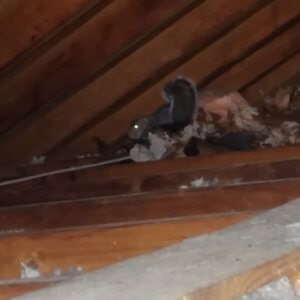Do you have nuisance wildlife concerns? Read more about some experiences our wildlife technicians have faced while providing safe and sustainable treatments in the Greater Baltimore area.
Groundhogs:
We received a call about a groundhog burrowing under a home. Groundhogs, a.k.a. Woodchucks, are not an inherently dangerous pest but their burrowing can be very destructive. Did you know that a groundhog burrow can stretch as long as 50 feet?! While groundhogs are normally destructive to just gardens and landscaping, the burrows from this groundhog were so extensive that the slab foundation started to sink! We were able to humanely capture and relocate our groundhog friend and provide the proper exclusionary methods to ensure this client would never have to deal with this problem again!
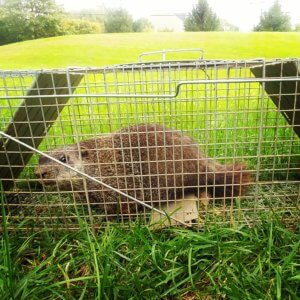
Opossums:
Chattering noises emanating from a basement is what drove this customer to call for our services. Our wildlife control team searched the basement to find a mother opossum with her babies. Our team was then able to remove these animals safely from the customer’s home and humanely relocate them. Opossums are America’s only marsupial, which means they carry their babies in a special pouch. They are nomadic creatures and will often take up temporary shelter under a porch, or even in an attic or basement if there is access. In this case, our technicians were able to find the entry point and seal it so that no other critters will take up residence in our customer’s home in the future.
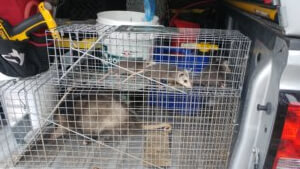
Starlings:
Starlings are an invasive species of birds. While mostly known for their large-scale damage to agricultural operations, they also pose a threat to the average homeowner as well. Starlings are crevice dwellers, meaning that they will build their nests in the cracks and gaps in a structure. A favorite spot for them is in dryer vents. Obstructions such as bird nests in dryer vents are a serious fire hazard, leading to almost 3,000 house fires a year in the U.S alone! Our wildlife technician was able to remove our trapped starling and install a pest-proof vent to prevent any further pests from causing hazards like this in the future.
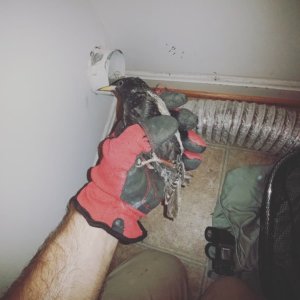
Raccoons:
Raccoons can pose several risks to homeowners. Nuisance wildlife control operators like us need to be well equipped to handle all circumstances. A mother raccoon was raising her kits in one customer’s chimney. Chimneys resemble tree hollows to many pests and are frequently inhabited if the chimney is not properly capped. Our wildlife team was able to remove all the raccoons by hand and secure the chimney to ensure no more unwelcome intruders will get in.
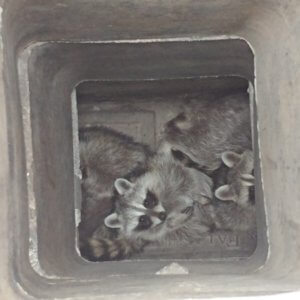
Foxes:
One Phoenix, Maryland customer was directed to us by the Department of Natural Resources as she had a sick fox trapped in her barn with her other animals. Foxes can carry dangerous diseases, such as rabies and mange. Sick animals need to be dealt with swiftly to minimize the risk of hurting people and pets. Our wildlife technician arrived on the scene in just 30 minutes! Shortly after, the fox was contained and removed from the property. Our technician worked with the customer to come up with preventative measures to ensure her animals’ future safety.
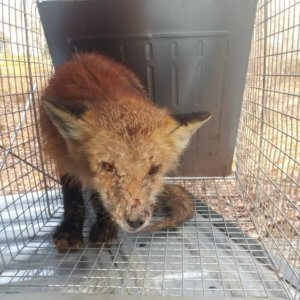
Bats:
Bats are nature’s mosquito control. Did you know a bat can eat up to 10,000 mosquitoes a night? Problems with bats begin when they try to shelter in attics and homes. Bats are carriers of rabies, and their guano contains deadly diseases. Therefore, our professionals are skilled in performing bat removal and exclusion. For this Timonium customer, our techs safely removed several bats from the attic, sealed up all of the entry points, and installed a bat box so that the customer could continue to reap the benefits of bats without the risk!

Snakes:
This Baltimore City resident received quite the surprise when a snake fell from his attic as he lowered the drop-down attic stairs. It turns out this young eastern black rat snake got his head stuck in the stairs! Rat snakes such as this one can grow up to eight feet long and commonly end up in attics and basements following a food source, such as mice. Our emergency wildlife tech responded immediately and was able to rescue both the snake and customer. Upon further inspection, the attic was found to have signs of snakes, mice, birds, and squirrels. Our technicians were able to find the entry points and conduct exclusion to keep this customer’s home free of wildlife.
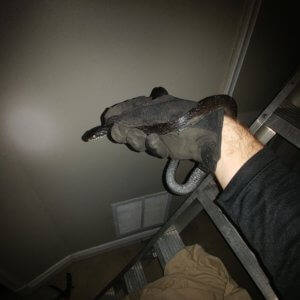
Flying Squirrels:
Flying Squirrels are actually quite common in Maryland, although they are not often seen due to their nocturnal nature. They get their name from the webbed skin that stretches from their front to their rear legs that enables them to glide distances of up to 200 feet! Their size enables them to fit into holes the size of a dime and, in this case, take refuge in an Owings Mills customer’s attic. Flying squirrels are a colonizing species and will live together in groups of up to 15 members. This creates quite a racket and quite a mess. Our wildlife team found the entry point, trapped the squirrels and sealed up the attic to prevent any future intrusions.
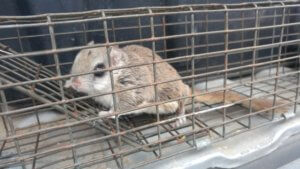
Owls:
Our wildlife technicians are ready to respond at all hours of the night. In this case, we received a late-night call from a customer with an Eastern Screech owl in her chimney. Screech owls are cavity nesters and will sometimes find themselves nesting in uncapped chimneys. Our wildlife team was up to the challenge and removed the owl while being careful not to hurt it. The chimney was capped, and the owl was set free, happy to be out of the chimney. What a hoot!
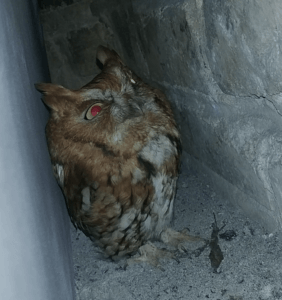
Squirrels:
Squirrels are our most common nuisance wildlife. The Eastern Grey squirrel has a habit of damaging homes to gain entry for nesting purposes. Once inside, they chew on wires, causing electrical fires. Finding the entry point can sometimes be difficult, and before sealing it up, a one-way door must be installed, and all the squirrels must be removed. Ideally, trees should be trimmed 5-10 feet away from the home to prevent squirrels from accessing the house in the future. Here, a squirrel had chewed the fascia board and made a nest in an attic. Our wildlife team was able to remove the animals and seal up all of the entry points so that squirrels will never get back in!
